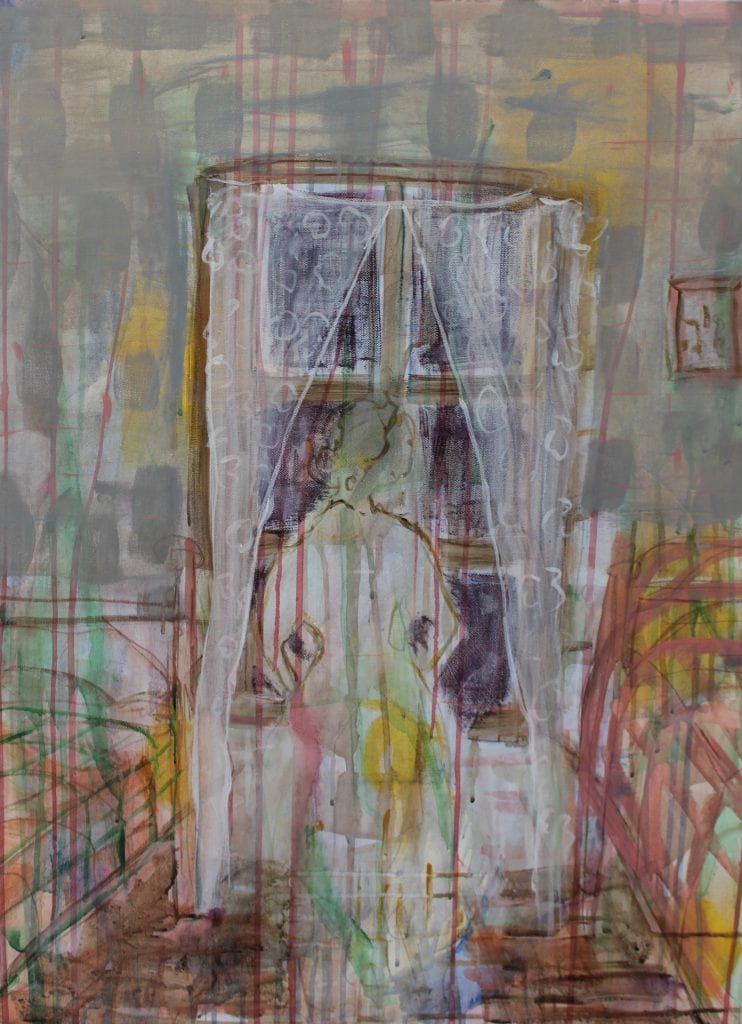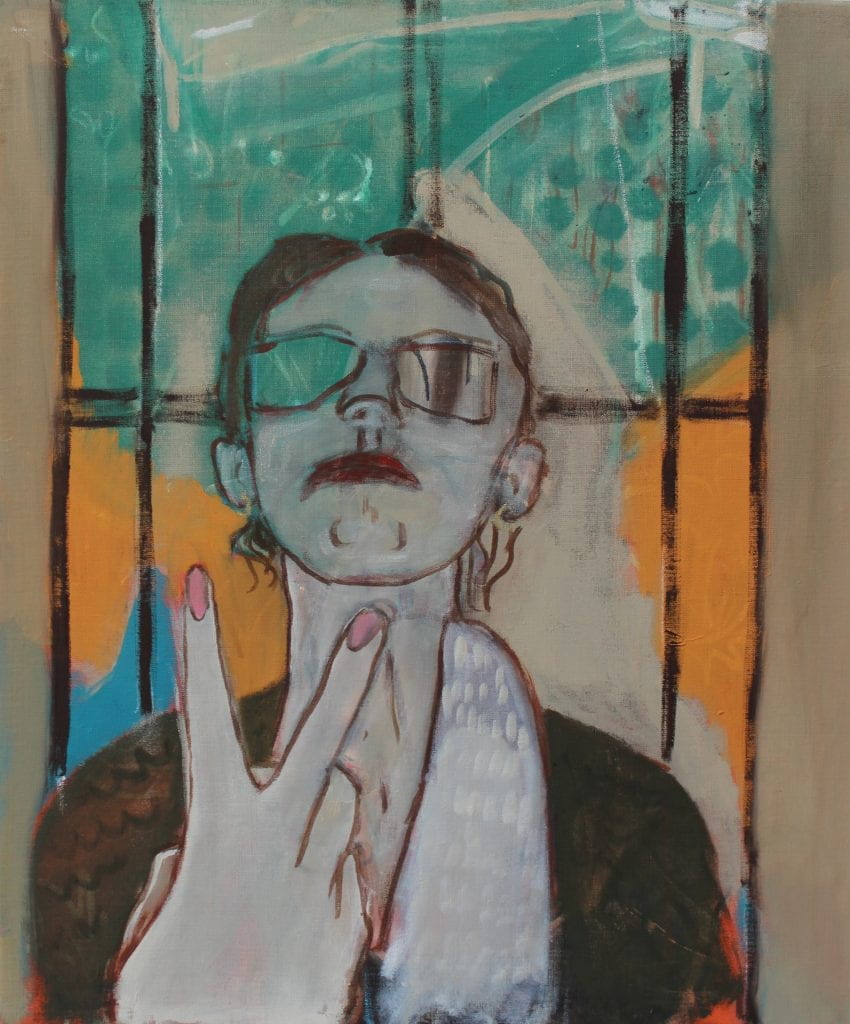Grace’s sanctuary in the room upstairs [El santuario de Grace en el cuarto de arriba], acrílico sobre lienzo
The Leer After AG [La lascivia tras AG], un hombre fijando la mirada e insinuándose a una mujer sentada sobre un banco, óleo y acrilico sobre placa
Sod off [Váyase al diablo], óleo sobre tela
Mi primera respuesta a la historia de Grace fue pintar su habitación, un cuarto completamente suyo donde se refugia al final del día. Quería profundizar en este momento de paz que crea para ella al final del día y proporcionarle el espacio y tiempo y quietud que necesita. En el cuadro Grace’s sanctuary in the room upstairs [El santuario de Grace en el cuarto de arriba], la pinté como si apenas existiera: una persona que se camufla con su entorno, apenas visible, un rastro de ella misma.
Este cuadro despertó mi curiosidad por saber si a lo largo de la historia, los pintores habían representado el problema de la violencia de género y de qué manera lo habían hecho. En esta línea, mis siguientes obras The Leer After AG [La lascivia tras AG] es una reinterpretación del cuadro de Artemisia Gentileschi, Susana y los viejos (1610). Esta pintura muestra a una mujer siendo acosada por dos viejos mientras se bañaba en el jardín. Intentan obligarla a aceptar una propuesta indecente, a la que ella se resiste. Los tipos proceden a acusarla de adulterio. En mis versiones de la pintura, retomo el lenguaje figurado histórico para destacar la sensación de intimidación y aversión que experimentan las mujeres del cuadro.
Mi investigación me ha demostrado que no soy el único que se ha inspirado en la historia del arte al abordar el problema contemporáneo de la violencia de género. Por ejemplo, otras artistas, crearon obras como una Woman returning a man’s stare [Mujeres devolviendo la mirada de un hombre] (1993), un cuadro de Rosie Wylie, galardonada con el Premio Turner. En su respuesta a la serie de cuadros de Tiziano denominada Venus recreándose en la música (1550), en la que aparece un hombre tocando un órgano y una mujer mirando hacia el otro lado en un intento de evitar sus insinuaciones. El cuadro de Artemisia Gentileschi Judith matando a Holofernes (1614-1620) representa el relato del Antiguo Testamento en el cual la heroína Judith asesina al general Holofernes. La obra muestra el momento en que Judith, con la ayuda de una sierva, decapita al general mientras este se queda profundamente dormido en un sopor etílico. Algunas críticas feministas han interpretado que estas pinturas representan una especie de venganza visual de Gentileschi tras haber sido víctima de una violación por parte de Agostino Tasso en 1611. Estas obras captaron mi interés en esta expresión de consciencia en las pinturas de Rosie Wylie y Artemisia Gentileschi, quienes dejan de retratar a la mujer en una actitud pasiva, evitando la mirada lascivia del hombre, y la colocan en una confrontación activa contra el perpetrador, a quien desafían con la mirada. Lejos de querer ser una víctima, deciden revertir la situación, valerse por sí mismas y defenderse. Estas reflexiones me motivaron a pintar Sod off [Váyase al diablo], un cuadro que representa la venganza de las mujeres por las heridas que les han infligido, su ira y su propia capacidad de tomar represalias violentas.
Grace’s sanctuary in the room upstairs, acrylic on canvas
The Leer After AG, one man peering and propositioning a woman sat on a bench, oil and acrylic on board
Sod off, Oil on linen
My first response to Grace’s story was to paint her bedroom, a room entirely hers to which she retreats at the end of the day. I wanted to expand on this moment of peace that she creates for herself at the end of the day and give her the space and time and quiet that she needs. In the painting Grace’s sanctuary in the room upstairs I have painted her as barely there – a subject that fades into her surroundings, barely detectable, a trace of herself.
This painting made me curious more generally about whether this issue of gender-based violence has been represented by painters’ art historically and how. In this vein my next paintings The Leer After AG is a reworking of the painting by Artemisia Gentileschi of Susanna and the Elders (1610.) This painting depicts a married women spied upon by two elders while bathing in the garden. They attempt to force themselves on her, demanding that she does not submit. They go on to accuse her of adultery. In my versions of the painting, I revisit art historical figurative language to try to highlight the sense of intimidation and aversion experienced by the women in the painting.
My research shows me that I am not alone in drawing upon art history to consider the contemporary issue of GBV. For instance, other artists such as the Turner Prize winning artist Rosie Wylie depicts a Women returning a man’s stare (1993). It is her response to Titian’s series of paintings of Venus with the Organists (1550) of a man playing an organ and a woman who looks the other way trying to avoid his advances. In Artemisia Gentileschi Judith Slaying Holofernes (1614-1620) which represents the tale from the Old Testament of the assassination of the General Holofernes by the heroine Judith. It shows the moment when Judith, helped by her maidservant, beheads the general after he has fallen asleep un a drunken stupor. Some feminist critics have interpreted these paintings as a form of visual revenge following Gentileschi rape by Agostino Tasso in 1611.
And I am interested in this sense of the awakening of the women in Rosie Wylie’s and Artemesia Gentileschi’s painting, who is no longer just passive and avoiding the man’s leer but actively confronts the perpetrator, returning and confront his stare. No longer wanting to be a victim she decides to turn the tables, stand up for herself, defend herself. These reflections led me to paint Sod off depicting women taking revenge for the injuries inflicted upon them, their anger, their own capacity for violent retaliation.



Acerca de la artista
Christina Reading vive y trabaja en Brighton. Estudió en la Central School of Art and Design de Central Saint Martins, Londres, la Universidad de Artes Creativas en Farnham, y la Universidad de Brighton. A través de su trabajo en dibujo, pintura y texto, Christina articula narrativas internas y conversaciones compartidas basados en sus propias experiencias y recuerdos, incorporando referencias de diversas fuentes, literarias, míticas, archivísticas y poéticas. Su obra aborda cuestiones como la narrativa, la teoría feminista y la creatividad. Además, es miembro de Studio 106 en Hove. Para más información, acude a su sitio www.christinareading.co.uk
About the artist
Christina Reading lives and works in Brighton. She studied at Central St Martins School of Institute of Art & Design, London, The University of the Creative Arts, Farnham, and The University of Brighton. Working in drawing, painting and text, Christina articulates internal narratives and shared conversations based on her own experience and memories, incorporating references to other literary, mythical, archival, and poetic sources, Christina work considers overlapping issues such as storytelling, feminist theory, creativity. She is a member of Studio 106 in Hove. www.christinareading.co.uk